Explanation of cycling-related traffic laws in Serbia. Answers to frequently asked questions and help to those not familiar with these laws, who wish to cycle in Serbia. Separate articles discuss:
- Electric bicycle and scooter regulation.
- US regulation for cycling under the influence of alcohol (and drugs).
TL/DR
Here, I’ve explained the traffic laws relevant for cyclists – along with some major misconceptions (who has the right of way and when).
It is related to Serbia, but the basic principles are the same in most other countries.
1. Introduction
Legal language can be confusing, so in this post I’ll explain in “plain English” the lawful rights and obligations of cyclist in Serbian traffic. Hopefully helping people who live, or just cycle through/in Serbia, stay safe and trouble free. Serbia is along the famous Danube cycling route, that starts from Germany and goes all the way to the Black Sea.
Current version of the law can be read (in Serbian) on the laws and regulations page, of Serbian police.
At the time of updating this article, the latest, September 2023 version of the Serbian traffic law, can only be found on the website of a private company paragraf.rs.
Here’s a copy of the Serbian traffic law (the previous law version, from 2019), on bikegremlin.com – just in case (last version of September 2023).
In the text, I’ll use brackets to note law articles, paragraphs, and items – for example:
[7-1-13] – article 7, paragraph 1, item 13
[9 – 3] – article 9, paragraph 3
I already wrote a series of articles on how to safely ride a bicycle in traffic, and how to safely lock a bicycle, for which I think are useful and apply to practically every country, while here I will deal with cycling related traffic rules and regulations.
2. Terms that should be memosized
In order to understand this text, without making it too long, I’ll define a few terms (as the law defines them):
- Low visibility conditions: night, fog, and/or rain – in this post I’ll just use the term “night” [7-1-80].
- Cycling lane – lane drawn on the side of the road, for cyclists to use [7-1-13].
- Bicycle path – path for cyclists, physically separate from the road [7-1-26].
People often mix bicycle paths and lanes, when interpreting the traffic law! - Bicycle-pedestrian path – path for cyclists and pedestrians [7-1-26a].
3. Helmet, lights, and safety equipment on a bicycle
Wearing a helmet on a bicycle is not required (but also not forbidden, of course).
At night, if standing on the road, or pushing a bicycle on the side of the road, you should wear a high-visibility vest [81].
At nigh, you must have white light in the front, and red light at the rear. Blinking lights are technically not in accordance with the law, so you need at least one light that is always on at the front and at the rear. And technically, the lights must be mounted on the bicycle (a helmet mounted light “doesn’t count”) [81-1-5].
I already wrote about bicycle lights. In my opinion, blinking light should be allowed for the rear – much more time for the drivers to spot it, and blinking does draw attention.
It is generally regarded that “bicycles must have brakes on both the front and the rear wheel”. I couldn’t find where it’s written in any law. Though it is sensible to have good working brakes on both wheel, in case one brake (or wheel) malfunctions.
4. Speed limits
- On a bicyle path: up to 35 km/h [89-1].
- On a bicycle-pedestrian path: up to 10 km/h [40-2].
- On the road and on cycling lane: general speed limit for the road applies.
5. Lane positioning and overtaking
People drive on the right side of the road in Serbia (which is bad, since most people mount/dismount bicycles and motorcycles from the left-hand side, thus stepping into the traffic, instead of to the side of the road – more info on that on worldstandards.eu).
Cyclists must ride within 1 metre from the right-hand side of the edge of the road, except when turning left on an intersection, or when overtaking [40-1].
This is not always safe, as I explained in the post about safe cycling traffic lane positioning. So I often consciously disregard this law – at my own “risk,” when that is a safer option (moving away from the door-zone of parked cars for example).
Overtaking a cyclist is generally always allowed, even when there is a no-overtaking sign [55-7].
There is no defined minimal overtaking distance – it is defined simply as “to not endanger the others” [55-2]. Why I think this is OK, is explained in the post: Safe bicycle overtaking distance.
Cycling lane can only be used along the right hand side of the road, relative to the direction of cycling (if a cycling lane is on the left hand side of the road, it mustn’t be used) [89-2]. Bicycle path, on the other hand, can be two-way [89-3].
In group rides, cyclists must go one behind the other(s), not abreast [89-4].
Cyclists are obliged to use a cycling lane, or a bicycle path, if they exist, i.e. in that case they mustn’t ride on the road [40-1]. Which I don’t really like, so I often choose roads without bicycle paths/lanes. But more on that later.
Cyclists mustn’t use motorways (highways, any roads where “vehicles slower” than 50 km/h are not allowed) [102-1].
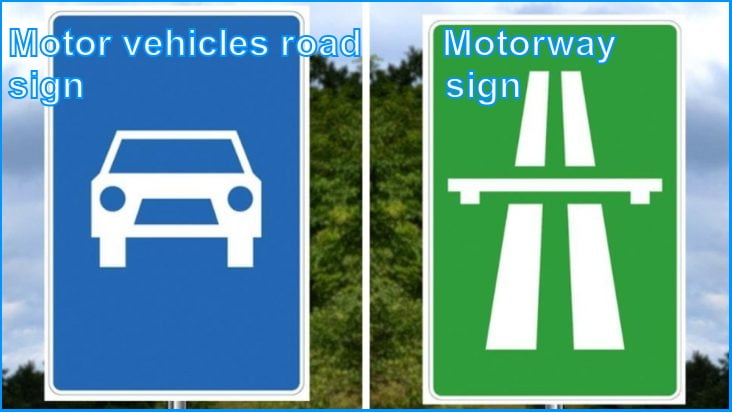
Picture 1
Likewise, cyclists may not use pedestrian paths for riding.
Article 7, paragraph 32 of Serbian traffic law defines a bicycle as a vehicle, so using pedestrian paths for cycling is forbidden, just as it is forbidden for driving cars on it.
6. Age restrictions
Kids under the age of 12 can’t ride on the roads, nor on cycling lanes (only on separate bicycle paths and similar) [88-1].
I think this is bad and, with primary school traffic law education, perhaps even with adult surveillance, kids should start cycling in traffic earlier.
In slow traffic zones, “30 zones”, and in pedestrian zones, kids from the age of 9 can ride bicycles [88-2].
In slow traffic zones and pedestrian zones, kids younger than 9 can ride bicycles, only under surveillance of a person older than 16 years [88-3].
The law implicitly forbids transport of kids in a bicycle child trailer [92].
It is also implicitly forbidden for kids under 18 years of age to transport other kids on a bicycle [118-1].
7. Drugs and alcohol (& rock n’ roll)
Drugs are generally illegal in Serbia, which goes for cycling as well.
Tolerated blood alcohol limit for cyclists is 0.20 mg/ml (less than one pint of beer) [187-3].
It is also not allowed to carry another person on a bicycle, if they are drunk, or drugged [91-2].
Drunk cycling (bike DUI) – laws and risks involved
8. Other bicycle related rules and regulations
When turning, one must signal the turn with a stretched out hand pointing the direction of the turn. Hand must be held during the entire manoeuvre [32-4], which is nonsense in my opinion (legislators obviously didn’t try riding uphill with only one hand on the handlebars).
No headphones in both ears [90-1-7].
No removing legs off the pedals, for as long as the bicycle is moving [90-1-2], which is also nonsense, as I had demonstrated in a video (in Serbian). No one has been fined for this for all I know.
No leading animals (like cycling with a dog) while cycling, nor pulling other vehicles (trailers are allowed) [90-1-4].
When walking on a road, walk on the left side of the road, facing the oncoming traffic. When pushing a bicycle, push it on the right side of the road, preferably (for safety) with the cyclist being closer to the edge of the road, with the bicycle on their left hand side.
9. Intersections and rights of way
If the traffic is not regulated by a sign, traffic lights, or a policeman, the vehicles coming from the right hand side have the right of way.
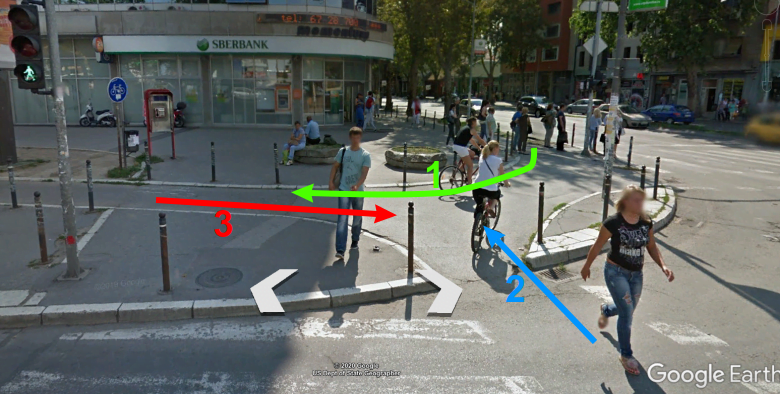
Yes, pedestrians and people with baby strollers often use bicycle paths in Novi Sad, although they shouldn’t
Picture 2 – source Google Earth
If a cyclist wishes to use a pedestrian “zebra crossing”, they must dismount and push the bicycle across the road, while walking.
If a bicycle path crosses the road, when there are traffic lights (as shown in picture 2, top left corner), then cyclists have the right of way when the light is green (as in the picture). What when there’s no traffic light?
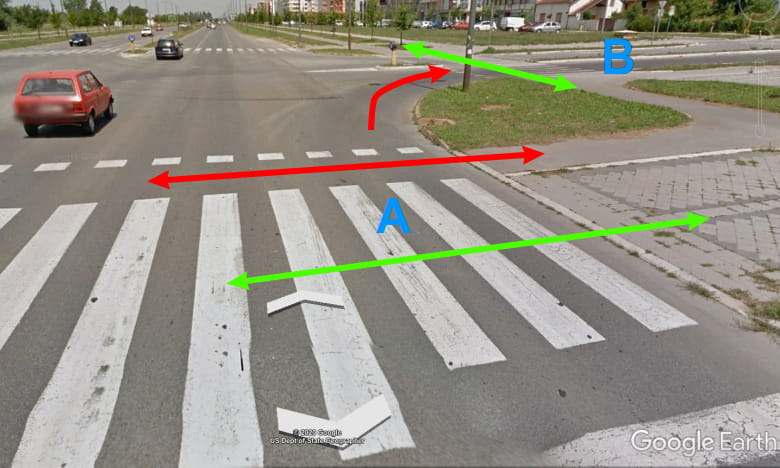
Situation A: pedestrians have the right of way on the zebra crossing, but cyclist’s don’t, where the cycling lane crosses the road.
Situation B: if a driver crosses a bicycle path/lane when turning, they must give way to the cyclists [47-2].
Picture 3 – source Google Earth
In Serbia, most drivers don’t look and don’t give the right of way in the situation B in picture 3, so take that into account.
9.1. Bicycle-related traffic signs
Here are some traffic signs related to bicycle paths (i.e. the paths physically separated from the motor-vehicle roads):
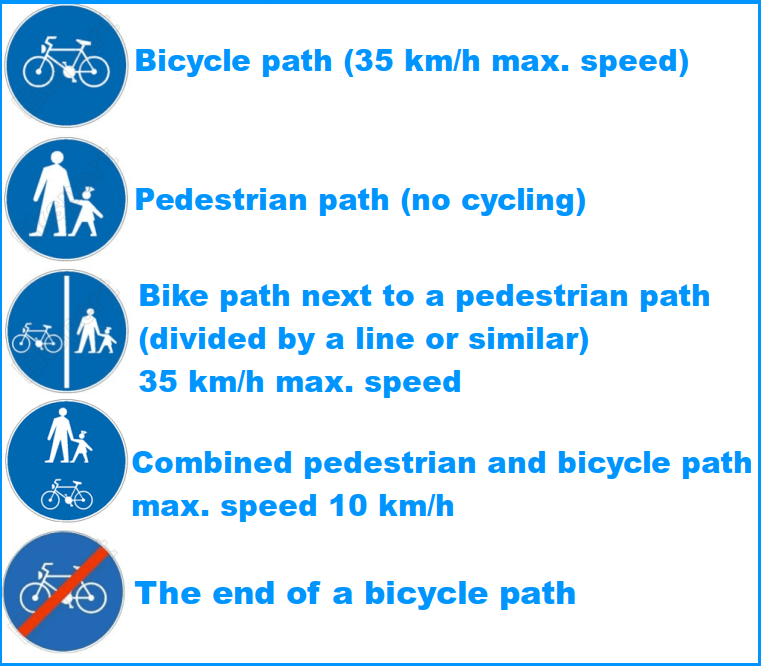
Picture 4
Below is a bicycle lane sign (unlike bicycle paths, bicycle lanes are not physically divided from the road, but just drawn with a line, like any other vehicle lane):
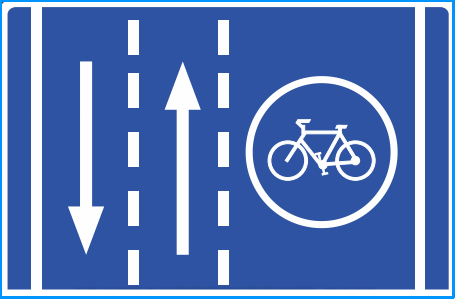
Picture 5
10. What to do in case of a traffic accident?
Remain calm and composed. If there are any injured, call the ambulance (dialing 194), and give first aid if that is needed and you know how to do it.
Write down the licence plates (sometimes people run away from the scene).
Call the police (dialing 192), or have someone else call if you are not able, for any reason.
Exchange the information with the others involved in the accident, checking each other’s documents. If they don’t want to give you any documents, just write down the plates and wait for the police.
Photograph everything at the scene. Photographing people without their consent is against the law (though I personally think it can be done discretely and be of more help than harm, but you do that at your own risk).
Wait for the police and don’t touch anything at the accident scene. Drivers, especially if they figure they’re “guilty”, will try to put the bicycle upright and move it from the road, “to clear the traffic”.
If you are hurt, ask someone to guard the accident scene until the police arrive (it can often take hours).
Material evidence often bears a lot more “weight” in court, than witness statements (people can get many friends to lie in their favour).
It is my personal impression and opinion that institutions in Serbia don’t work well at all, and there is a very high level of corruption. So it is often good to hire a good and experienced lawyer.
11. Video about cycling in traffic – safely
In the video below, I demonstrated how to ride a bicycle in heavy traffic while remaining safe:
I made a separate video to explain and demonstrate how to use the bicycle lanes and separated bicycle paths safely:
12. ELECTRIC scooters
From September 2023, Serbian traffic law recognises the electric scooters.
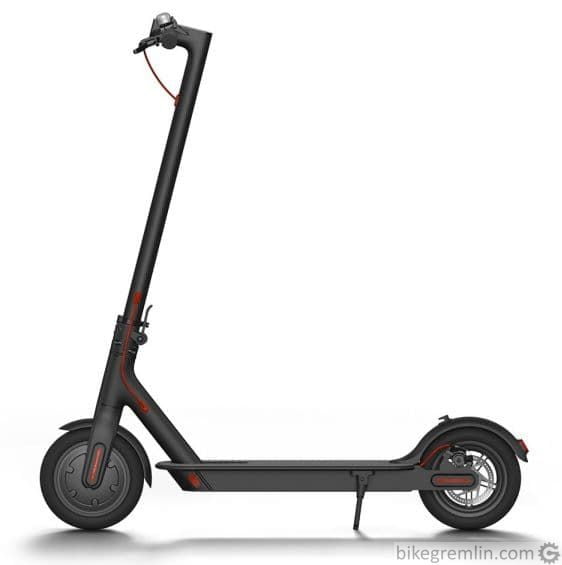
Picture 6
[7-1-31a] defines it as a “light electric vehicle… without any seats.”
Traffic rules for electric scooters are practically the same as the traffic rules for bicycles, with a few exceptions (basically, everything is even stricter, more restrictive):
- A cycling helmet is obligatory for electric scooters (and it is not obligatory for bicycles) [91-3].
- Children under the age of 14 years are not allowed to ride them on public roads (for bicycles, this limit is set to 12 years) [88a].
- If there is no bicycle path or lane, the rider must use public roads, but only if the roads’ speed limit is up to:
30 km/h – for riders under 18 years of age [92a-2].
50 km/h – for 18+ year old riders [92a-3].
So, no inter-city roads, which the cyclists are allowed to use. - The rider must wear a hi-vis vest when using public roads [92b-2].
- A special sticker issued by the traffic safety agency is needed to allow riding on public roads (i.e. not just on bicycle lanes and tracks) [92g].
Still only on roads with speed limits as defined a few lines above.
Starting June 2024, electric scooters must be registered in Serbia (with a registration sticker and a tax paid). I wrote a separate article about the mandatory electric scooter registration.
13. Electric bicycles
As far as I can tell, Serbian traffic laws don’t recognize electric bicycles.
Last updated:
Originally published:

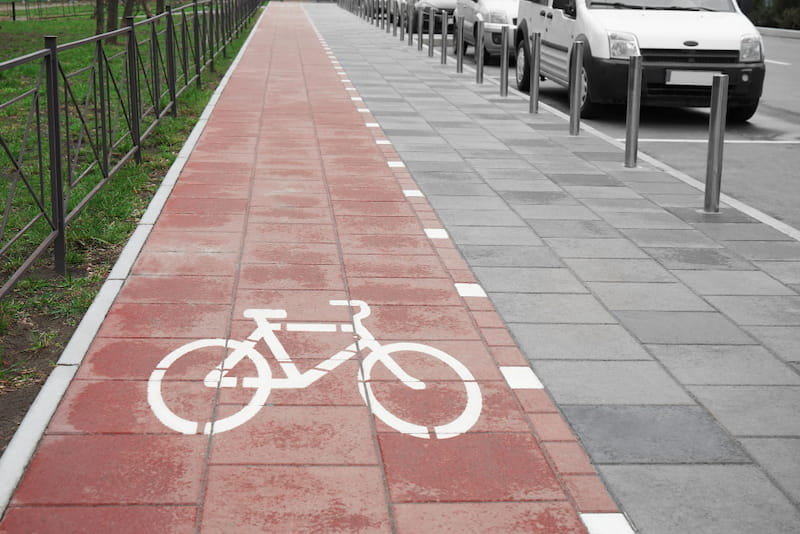
Great article – thanks for the info.
You said that “Cyclists mustn’t use motorways (highways, any roads where “vehicles slower” than 50 km/h are not allowed) [102-1]” – I’m doing a ride through Serbia in the Summer (entering in the North and leaving in the South) and am planning my route…but I don’t know how to check if any of the roads on my route are highways. For example, would taking the E65 Road south from Gostivar be ok? Can you recommend an app for road cycling route planning through Serbia?
Thanks!
Hi David,
I’ve edited the article to include photos of the relevant traffic signs (I’m not completely sure what the “road dedicated to motor vehicles which is not a motorway” is correctly called in English).
The E65 route goes around Serbia as far as I know (it does go through Kosovo, but that’s no longer a part of Serbia and I haven’t travelled there in decades).
I would recommend you open an account on the 2bike.rs (the best Serbian cycling-related forum, and if memory serves me, some members have cycled through Kosovo and around the surrounding countries) and post a question in its English language section.
Regarding Serbia, if it’s of any help:
In practice, in Serbia, one can do anything, but nothing is done normally, by the book. For example, the bridge connecting my city (Novi Sad) to the other side of the river where my mother lives is defined as dedicated to motor vehicles, but there is no bicycle path/bridge, so I regularly use its breakdown lane to get across (using the appropriate side of the road of course). Officially, I should get fined each time, but cyclists use that regularly with no problems (about once each year, newspapers publish an article saying that some cyclist was fined doing that).
Similar goes for using one-way streets in the opposite direction when cycling. Only a few years ago was that officially allowed (with a matching sign), but it’s been my practice for decades.
Being safe, predictable and polite goes a long way, even when dealing with the traffic police.
Here’s what I do:
I choose roads with less traffic, preferably with slower traffic. Note that some “smaller” roads are more dangerous than motorway sections (thanks to motorways having good visibility and the breakdown lane), i.e. not every road that looks small on the map is very safe (not that I would generally advise using motorways with a bicycle, especially near Belgrade, the capital).
Of course, navigating this requires a very good understanding of the local traffic situation, so may not be possible for everyone. Fortunately, there is the “Danube cycling road” that goes all the way from Germany, to the Black Sea. This is a very detailed guide, though in Serbian (I hope at least the map and the photos will help):
http://www.ciklonaut.com/svrbiguz/dunav/dunav.htm
The northern part is very flat and the traffic is OK. South is a lot more tricky in my opinion and experience. If you enter in the north and go southeast, you can use the Danube cycling path. However, if you intend to go south, or southwest, I’m not sure what the good cycling paths are (mostly used a motorcycle for travelling those parts, and thanks to its speed, it’s a lot safer on many high-traffic roads).
Relja
Thanks Relja – this is really useful information. I appreciate it! I’ll check out the 2bike forum as well. Regards.
David